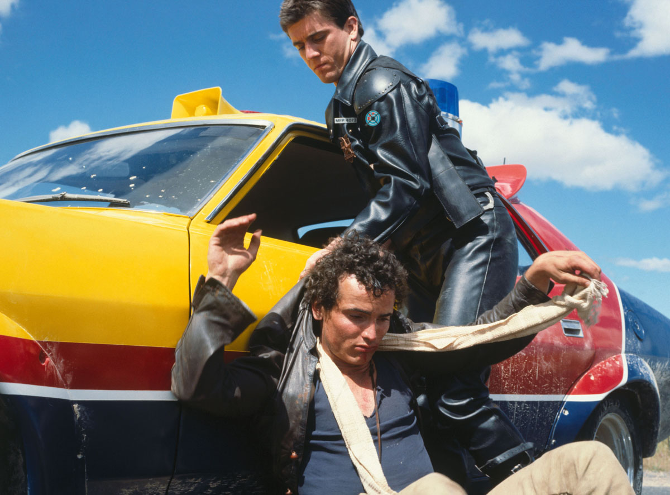You’ve got to give credit to guerrilla film making. Usually encompassing a newish director and actors, a limited budget, rebellious on-location shoots, and a certain disregard for rules and regulations (mostly due to a lack of money), some of cinemas most unique and creative pictures have come from this cheap form of movie making. Think Rocky, The Evil Dead, El Mariachi, Clerks, and today’s motion picture, Mad Max (1979).
Made for 400 thousand Australian dollars, it went on to make more than 100 million US worldwide – at that point holding the Guinness Book of World Records for most profitable film (only losing it in 1999 to The Blair Witch Project). Putting writer/director George Miller and star Mel Gibson (in his first leading role) on the map, it also thrust Australian New Wave cinema into global consciousness, while bringing forth a surge in dystopic movies that dealt with similar ideas and themes. In fact, it was such a success, it also spawned three sequels – Mad Max 2 aka The Road Warrior (1981), Mad Max Beyond Thunderdome (1985), and the Gibson-less Mad Max: Fury Road (2015). . . this most recent effort considered an instant classic (and one of the best reviewed films of the year).
Set in a dusty, slowly decaying Australian landscape (in the not so distant future), this is not the world you will see in the sequels (with pure bedlam and a planet on the precipice of death), but still, all is not right. Lawlessness is starting to rule the land, with the highways being the prime stomping grounds for a number of violent gangs. . . whose questionable hobbies include terrorizing rural townsfolk, raping women, and running people off the road in a most deadly way.
Loosely following a classic western narrative (along the lines of pictures like High Noon), the main protagonist is a highway patrolman, ‘Mad’ Max Rockatansky (Gibson), the top officer on the force (and a man who loves the thrill of the job). Married to Jessie (Joanne Samuel) and with a young son, he actually has a pretty good life in this slowly deteriorating landscape.
Opening with a highspeed chase, the action set piece concludes with Max killing the speedster. . . unbeknownst to him, the man is a member of a gang led by the menacing, if dangerously alluring Toecutter (Hugh Keays-Byrne – who also plays the main baddie in Fury Road). . . and, instead of coming into town by way of train (à la western), they are ominously heard roaring in on their motorcycles (Easy Rider this is not).
As the local population are quelled into forced submission by the savage fear that the gang brings to town, Max’s friends also fail and fall at the hands of these unruly riders. Things continue to decay, and soon, the only solution seems to be for Max to go rogue. . . the top cop going full-on vigilante to try to put an end to this frenzied gang.
What stands out most about Mad Max perhaps, is its go for broke style. Before CGI, and with too low of a budget to get proper stunt doubles, everything you are watching onscreen is real. All of the secondary bikers that are part of the gang were actually part of an actual biker gang called The Vigilantes (and did their own stunts). In regards to this, the scene that immediately stands out is a gruesome crash where one of the bikers gets his head hammered by a passing bike tire (in the special features, Gibson reminisces that when the man’s helmet came off, blood was coming out of his ears, nose and mouth). Funnily enough, Miller’s guerrilla film making style had the crew closing down streets they did not have permission to shoot on, washing them down after filming and then taking off before the police arrived. . . but, the police soon got word, yet were intrigued rather than upset, and began closing off the roads in coordination with the film crew.
An interesting sidenote, Miller actually raised the money for the movie by working as an emergency room doctor (and, some gruesome things he witnessed on the job likely inspired some of the scenes seen in the film). Even a more unique sidenote, most of the extras were paid with beer – it is up to you as to whether it was a better deal for the extras or producers.
A film of desperation and pain, hope is still a major factor. In many ways, the echoes of what happens in this story are still felt in Fury Road (despite Gibson being replaced by Tom Hardy). . . the loss and the tragedy of what is stolen from Max, a driving factor in his life and the reason why he helps Furiosa. Similarly, the roots for the stunts attempted thirty-six years later can all be found in this original feature – the crashes, people leaping onto gas trucks, the revengeful acts (it is all here).
The final touch is a flavourful, dynamic, Bernard Herrmann-like score written by Brian May (not the guitarist from Queen), all of it coming together to make Mad Max a cult classic – that has only become more lauded over the years (original reviews were mixed). With the visual style of a silent movie, it grabs your attention, holding you in its grips till the final jarring sequence. So, put the pedal to the metal and rediscover this explosive Aussie export – mad has never felt better!



